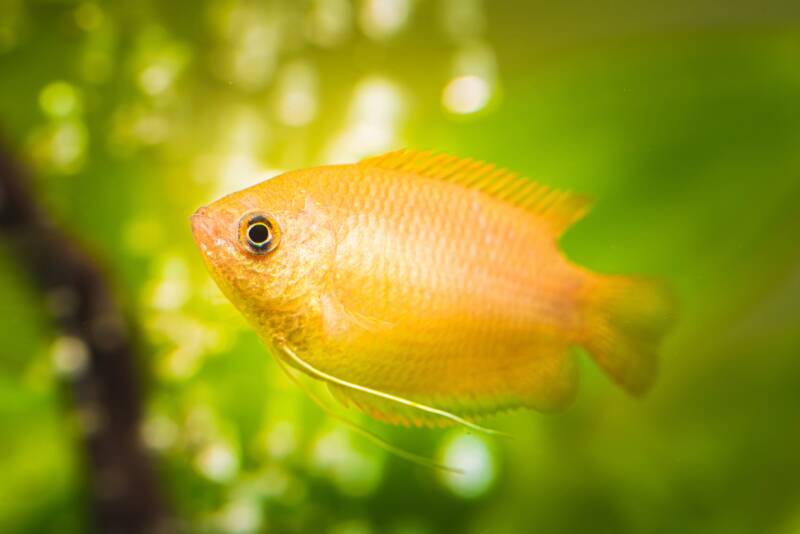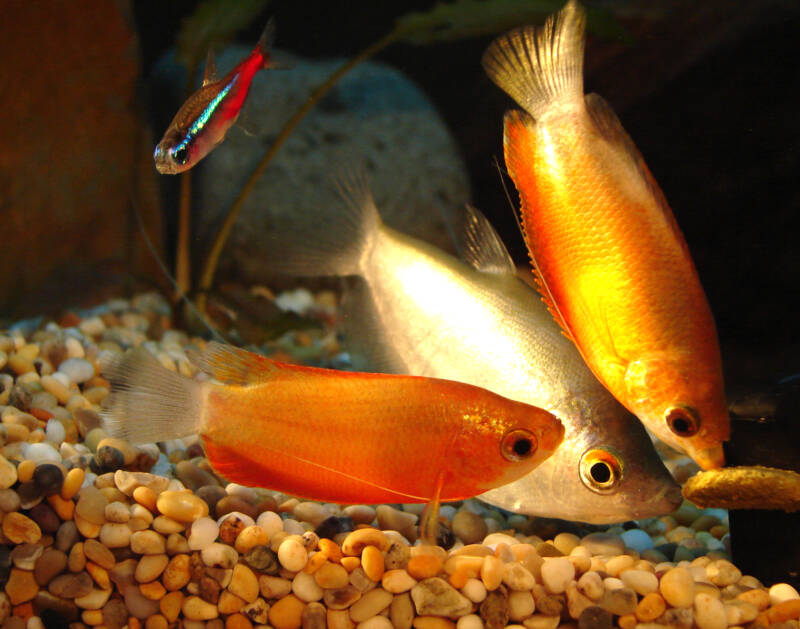Honey Gourami are an excellent choice for aquarists seeking peaceful and colorful fish for their community a
Honey Gouramis (Trichogaster chuna) are a fantastic choice for aquarists seeking peaceful, colorful, and low-maintenance fish. Reaching just 2–3 inches (5–7.5 cm), these golden beauties add vibrance and personality to any community tank.
What makes them special?
- Calm demeanor: Rarely aggressive, making them ideal for community tanks.
- Interactive personality: They often swim to the glass and explore the mid-to-top tank levels.
- Hardy nature: Easy to care for, perfect for beginners and experts alike.
In this guide, we’ll cover everything you need—from tank setup to breeding—to keep your Honey Gourami thriving.

At a Glance
| Parameter | Requirement |
|---|---|
| Tank Size | 10+ gallons (38+ liters) |
| Temperature | 70–82°F (21–28°C) |
| pH | 6.5–7.5 (slightly acidic) |
| Hardness | 6–13 dGH |
| Lifespan | 4–8 years (with proper care) |
Origins & Natural Habitat
Native to India and Bangladesh, Honey Gouramis thrive in slow-moving, tannin-rich waters filled with leaf litter and dense vegetation. Interestingly, their small size and golden color help them blend in like fallen leaves—a natural camouflage!
Key habitat notes:
- Blackwater adapted: Prefers soft, acidic water with driftwood and botanicals.
- Low-flow environments: Avoid strong currents (they’re slow swimmers!).
Appearance & Behavior
Color
- Males: Vibrant honey-gold with dark blue accents (especially when breeding).
- Females: Paler, with silvery-yellow hues.
Pro Tip: Stress or poor conditions dull their colors. A happy gourami glows like liquid gold!
Size & Temperament
- Males: Up to 3 inches (7.5 cm).
- Females: Slightly smaller (~2 inches/5 cm).
- Behavior: Peaceful but shy; avoid fin-nippers like Tiger Barbs.
Note: Males may chase each other briefly to establish hierarchy—this is normal.
Tank Setup Guide
1. Tank Size & Decor
- Minimum: 10 gallons for a pair. Add 5 gallons per extra fish.
- Decor: Floating plants (Hornwort, Duckweed), driftwood, and leaf litter to mimic their habitat.
- Substrate: Optional, but aquatic soil helps buffer pH for plants.
2. Water Parameters
- Flow: Gentle (use a sponge filter).
- Lighting: Low to moderate (they prefer shaded areas).
- Water Changes: 25% weekly to keep nitrates <20 ppm.
Diet & Feeding
Omnivores—but prone to bloating if fed improperly!
| Food Type | Examples | Frequency |
|---|---|---|
| Staple Diet | High-quality micro-pellets | 1–2x daily |
| Live/Frozen Foods | Bloodworms, Daphnia | 2–3x weekly |
| Vegetables | Blanched zucchini, peas | 1x weekly |
Warning: Avoid overfeeding! Uneaten food = poor water quality.
Sexing
Honey gouramis are sexually dimorphic, which means you can tell the males apart from the females visually via physiological differences.
Males once established are a bright maple color while females, once sexually mature are slightly smaller and have a paler color as compared to their male counterparts.
Also, males display brighter colors, like dark blue around their abdomen, during the breeding season. They also have generally sharper features as compared to females which tend to have more rounded features.
Diet & Feeding
Omnivores—but prone to bloating if fed improperly!
| Food Type | Examples | Frequency |
|---|---|---|
| Staple Diet | High-quality micro-pellets | 1–2x daily |
| Live/Frozen Foods | Bloodworms, Daphnia | 2–3x weekly |
| Vegetables | Blanched zucchini, peas | 1x weekly |
Warning: Avoid overfeeding! Uneaten food = poor water quality.
Tank Size
Due to its small size and generally sedentary disposition, the honey gourami does not need a big tank. A 10 gallon (20 l) planted tank for a pair will do just fine.
Our general rule of thumb is to start with 10 gallons and add 1 gallon per inch of fish you want to add.
For example, if you’d like to add another 5 more 2-inch fishes to the tank, the minimum tank size you should have would be 10 gallons plus another 10 gallons for the additional fish which makes 20 gallons.
Not much equipment is required for keeping honey gouramis, however, a low power internal filter or a sponge filter is highly recommended as it keeps the water from going stagnant and helps to prevent dead spots in the tank.
Some owners even opt to keep them in a planted tank without any added filtration!
https://www.youtube.com/watch?v=extSaiMUbQI
Parameters
The honey gourami does well in tanks that have slow-moving water flow, much like their natural habitat where they usually occur in slow-moving streams and stagnant pools.
As they are not fast fish, slow-moving water helps them feed easier and creates a less stressful environment for them.
Heating might be required for this species if you are located in colder parts of the world. However, heating is usually not required as they are a tropical species and can withstand temperatures anywhere from 70°F (21°C) to 82°F (28°C).
As for water parameters, the honey gourami originates from softer waters that are generally rich in tannins due to the abundance of fallen trees and plant matter that are commonly present within their habitat. A general hardness of around 6-13 dGH is recommended with a slightly lower pH range from 6.5–7.5.
Ammonia, nitrites, and nitrates should be kept to a minimum as this species stresses out easily. Weekly water changes of 25% total volume should be made to keep them healthy.
Decor
In the wild, their habitat is filled with fallen logs, sticks, leaf litter, and aquatic plants. While they will do fine without many decors, it is best for them to have as much hiding space as possible.
Live plants also have the added benefit of oxygenating and reducing nitrates in the water. Honey gouramis tend to spend much of their day in a certain spot of the tank, much like a floating leaf.
The substrate is usually not needed however it is recommended if you are keeping plants in the tank.
Some substrate (like aquatic soil) also helps to buffer pH which is an added benefit considering they enjoy slightly acidic water.
Tank mates

The honey gourami is a very peaceful and usually reclusive species of fish. The most common aquarium fish like guppies and mollies will make very good tank mates.
However, there are certain species of fish that you should steer away from if you decide to house them in a community tank.
Below is a classification of types of fish that will not make suitable tank mates.
- Aggressive fish: Aggressive fish tend to stress tank mates out due to their territorial behavior. Fishes like betta splendens will attack most fish that infringe their territory.
- Carnivorous fish: Fishes that have a diet that consists of other fishes are a big NO. Fishes like arowanas and various species of catfish, should not be housed with honey gouramis as they will make a good snack for these carnivorous fishes!
- Large fish: Large fish tend to stress out their tank mates due to their larger disposition. Fishes like koi and big goldfish while do not necessarily attack are aggressive, they are very zealous especially when it comes to feeding.
- Fin nippers: Fish like neon tetras and tiger barbs don’t make good tank mates because they tend to nip at fins. Slow-moving fish like honey gouramis make perfect targets for fin nippers as they generally don’t move much and are docile.
If the fish you intend to get falls within one of these 4 categories, we highly recommend you reconsider the decision as this will cause a lot of stress for your honey gouramis.
Diet
The honey gourami, like most of its cousins, is an omnivorous fish. This means that their diet consists of both animal and plant matter.
It’s is very important because they often suffer from problems such as bloating and impaction due to an improper diet in the aquarium. While most commercially available floating pellets are sufficient nutritionally, they are still chemically processed and manufactured.
In the wild, they are opportunistic feeders and live near the surface of the water to feed on insects that come too close.
Therefore, feeding them should involve both commercially available pellets as well as fresh foods such as bloodworms or tubifex worms, to stimulate a healthy digestive system.
Another problem with commercially available feeds is that owners tend to overfeed, resulting in easily bloated fish due to the lack of water content in the dry food, causing the food pellets to rapidly expand once the fishes ingest too much of it.
Breeding: Step-by-Step
- Condition the Pair: Feed protein-rich foods (e.g., brine shrimp) for 2 weeks.
- Bubble Nest: Males build nests using saliva under floating plants.
- Spawning: Male wraps around female; she releases 300+ eggs.
- Fry Care: Remove parents after spawning. Feed fry infusoria for 2 weeks, then baby brine shrimp.
Note: Breeding tanks should be shallow (10–12 inches) and covered (labyrinth fry need humid air).
Common Health Issues
| Disease | Symptoms | Prevention/Treatment |
|---|---|---|
| Fin Rot | Frayed, discolored fins | Clean water + Indian Almond Leaves. |
| Bloat | Swollen belly | Fast for 2 days; feed peas. |
| Ich | White spots | Raise temp to 86°F (30°C) + salt. |
Key Tip: Quarantine new fish to prevent outbreaks!
Feeding the fry
Most keepers opt to feed liquid fry food or infusoria at this stage up until the fry are large enough to consume baby brine shrimp or daphnia. This should take about 2 weeks before they can be switched over.
During the first 2 weeks, the fry should be fed 3-4 times daily and once they have been switched over to baby brine shrimp they can be fed twice a day.
Interesting facts about the honey gourami
The honey gourami is an interesting fish because they possess an additional breathing organ called the labyrinth. In the wild, most of their habitat consists of oxygen-deprived waters, as such this organ comes in handy!
Like most other fishes, the honey gourami also possess gills that enable them to breathe in the water, however, the labyrinth allows them to extract oxygen from the air.
Although most aquarium environments are oxygen-rich, they still like to spend most of their time close to the surface of the water, much like they do in the wild!
Of course, this does not mean that they can survive on land because they can extract oxygen from the air, rather this organ aids the extraction of oxygen so that they can survive in environments with little to no oxygen.
Common diseases
Due to their sedentary nature and opportunistic feeding habits, coupled with the harsh environment that they originate from, they are surprisingly hardy fish and are quite disease resistant.
However, they are prone to certain diseases such as impaction, fin rot, and bloating, as we mentioned earlier in the article.
Impaction
Unlike other fish that swim freely in the water column, honey gouramis love their spot and will stay there for most of the day with little movement.
This causes a problem as they have a relatively short digestive tract and commercial pellets tend to be very dry. Blockages are common if you do not vary their diet with raw food such as tubifex worms or bloodworms.
Fin Rot
Fin rot is a common problem within aquariums that have slow-moving water flow and bad care. Fin rot is a bacterial infection that is easily prevented by consistent water changes.
When the water quality improves, the chances of fin rot are negligible
Bloating
Bloating and impaction are closely related. However unlike impaction, bloating occurs due to a gas buildup inside the fishes digestive tract.
To prevent bloating, a varied diet is a must. Some remedies for bloating include feeding your fish boiled peas or to stop feeding for a few days to let the digestive tract work itself out before feeding again.
Final Thoughts
Honey Gouramis are low-maintenance, personable, and stunning—making them perfect for nano tanks or communities. By following this guide, you’ll enjoy their golden charm for years to come.
Got questions? Ask below! We love helping fellow aquarists.

